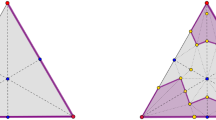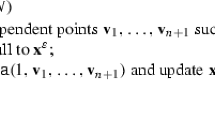Abstract
In this paper, we study a cell of the subdivision induced by a union of n half lines (or rays) in the plane. We present two results. The first one is a novel proof of the O(n) bound on the number of edges of the boundary of such a cell, which is essentially of methodological interest. The second is an algorithm for constructing the boundary of any cell, which runs in optimal Θ(n log n) time. A byproduct of our results are the notions of skeleton and of skeletal order, which may be of interest in their own right.
This work was partly supported by the CEE ESPRIT Project P-940, by the Ecole Normale Supérieure, Paris, France, and by the NSF grant ECS-84-10902.
This work was done in part while this author was visiting the Ecole Normale Supérieure, Paris, France.
Preview
Unable to display preview. Download preview PDF.
Similar content being viewed by others
References
M. Atallah: Dynamic Computational Geometry, Proc. 24th IEEE Symp. on Foundations of Computer Science, 92–99; Oct. 1983.
P. Alevizos, J.D. Boissonnat, and M. Yvinec: An optimal O(n log n) Algorithm for Contour Reconstruction from Rays, Proc. 3rd ACM Symposium on Computational Geometry, Waterloo, 162–170; June 1987.
B. Chazelle and L. Guibas: Visibility and Intersection Problems in Plane Geometry, Proc. 1st ACM Symposium on Computational Geometry, Baltimore, 135–147; June 1985.
B. Chazelle, L. Guibas, and D.T. Lee: The Power of Geometric Duality, BIT 25, 76–90; (1985).
S. Hart and M. Sharir: Non Linearity of Davenport-Schinzel Sequences and of Generalized Path Compression Schemes, Combinatorica 6(2), 151–177 (1986).
H. Edelsbrunner, L.J. Guibas, and M. Sharir: The Complexity of Many Faces in Arrangements of Lines and Segments, Prof. 4th ACM Symposium on Computational Geometry, Urbana, 44–56; June 1988.
H. Edelsbrunner, J. O'Rourke, and R. Seidel: Constructing Arrangements of Lines and Hyperplanes with Applications, SIAM J. Comp. 15, 341–363 (1986).
L. J. Guibas, M. Sharir, and S. Sifrony: On the General Motion Planning Problem with Two Degrees of Freedom, Prof. 4th ACM Symposium on Computational Geometry, Urbana, 319–329; June 1988.
R. Pollack, M. Sharir, and S. Sifrony: Separating Two Simple Polygons by a Sequence of Translations, Discrete Comp. Geom. 3:123–136 (1988).
A. Wiernik and M. Sharir: Planar Realizations of Nonlinear Davenport — Schinzel Sequences by Segments, Discrete Comp. Geom. 3:15–47 (1988).
Author information
Authors and Affiliations
Editor information
Rights and permissions
Copyright information
© 1989 Springer-Verlag Berlin Heidelberg
About this paper
Cite this paper
Alevizos, P., Boissonnat, JD., Preparata, F.P. (1989). An optimal algorithm for the boundary of a cell in a union of rays. In: Boissonnat, J.D., Laumond, J.P. (eds) Geometry and Robotics. GeoRob 1988. Lecture Notes in Computer Science, vol 391. Springer, Berlin, Heidelberg. https://doi.org/10.1007/3-540-51683-2_34
Download citation
DOI: https://doi.org/10.1007/3-540-51683-2_34
Published:
Publisher Name: Springer, Berlin, Heidelberg
Print ISBN: 978-3-540-51683-5
Online ISBN: 978-3-540-46748-9
eBook Packages: Springer Book Archive




